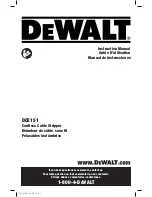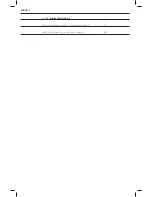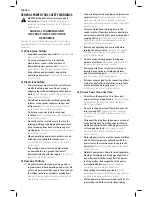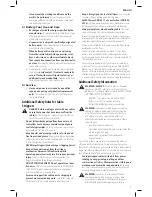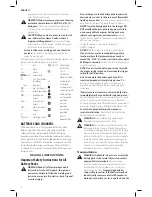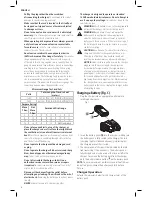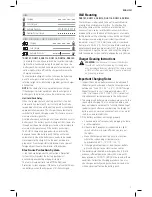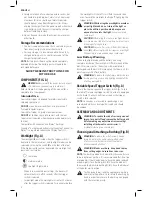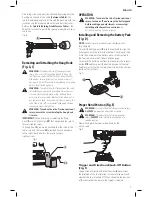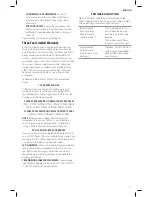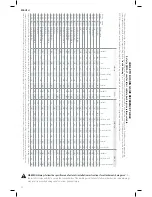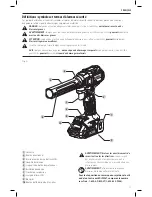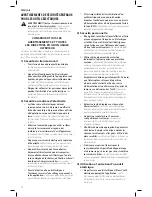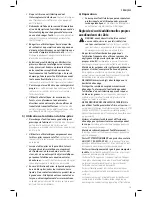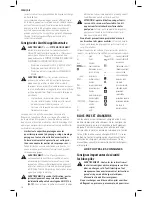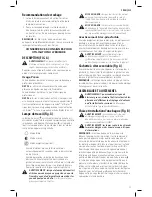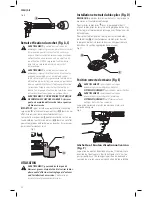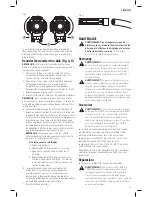
English
8
5. Foreign materials of a conductive nature such as, but
not limited to, grinding dust, metal chips, steel wool,
aluminum foil, or any buildup of metallic particles
should be kept away from charger cavities. Always
unplug the charger from the power supply when there
is no battery pack in the cavity. Unplug the charger
before attempting to clean.
6. Do not freeze or immerse the charger in water or any
other liquid.
Storage Recommendations
1. The best storage place is one that is cool and dry, away
from direct sunlight and excess heat or cold.
2. For long storage, it is recommended to store a fully
charged battery pack in a cool dry place out of the
charger for optimal results.
nOTE:
Battery packs should not be stored completely
depleted of charge. The battery pack will need to be
recharged before use.
SAVE THESE INSTRUCTIONS FOR
FUTURE USE
COMPONENTS (FIG. A)
WARNING:
Never modify the power tool or any part
of it. Damage or personal injury could result.
Refer to Figure A at the beginning of this manual for a
complete list of components.
Intended Use
Your cable stripper is designed for professional cable
stripping applications.
DO nOT
use under wet conditions or in presence of
flammable liquids or gases.
Your cable stripper is a professional power tool.
DO nOT
let children come into contact with the tool.
Supervision is required when inexperienced operators use
this tool.
Compatible with Greenlee® and Ripley® bushings.
Greenlee® is a registered trademark of Greenlee Textron, Inc.
Ripley® is a registered trademark of Ripley Tools, LLC.
Worklight (Fig. A)
The worklight
8
is activated when the trigger switch is
depressed. The low, medium, and spotlight modes can be
selected by moving the switch
3
on the foot of the tool.
If the trigger switch remains depressed, the worklight will
remain on in all modes.
low mode
medium mode
spotlight (high) mode
• When in low and medium settings, the beam will
automatically turn off 20 seconds after the trigger
switch is released.
• In spotlight mode the worklight will run for 20 minutes
after the trigger switch is released. Two minutes before
the worklight will shut off, it will flash twice and then
dim. To avoid the worklight shutting off, lightly tap the
trigger switch.
WARNING:
While using the worklight in medium
or spotlight mode, do not stare at the light or
place the drill in a position which may cause
anyone to stare into the light.
Serious eye injury
could result.
CAUTION:
When using the tool as a spotlight, be sure
it is secured on a stable surface where it will not cause
a tripping or falling hazard.
CAUTION:
Remove all accessories from the stripping
barrel
6
before using the cable stripper as a spotlight.
Personal injury or property damage could result.
Low Battery Warning
When in spotlight mode and the battery is nearing
complete discharge, the worklight will flash twice and then
dim. After two minutes, the battery will be completely
discharged and the drill will immediately shut down. At this
point, replace with a fresh battery.
WARNING:
To reduce the risk of injury, always have a
back-up battery or secondary lighting available if the
situation warrants it.
Variable Speed Trigger Switch (Fig. A)
To turn the tool on, squeeze the trigger switch
1
. To turn
the tool off, release the trigger switch, Your tool is equipped
with a brake. The chuck will stop as soon as the trigger
switch is fully released.
nOTE:
Continuous use in variable speed range is not
recommended. It may damage the switch and should
be avoided.
ASSEMBLY AND ADJUSTMENTS
WARNING: To reduce the risk of serious personal
injury, turn unit off and remove the battery pack
before making any adjustments or removing/
installing attachments or accessories.
An
accidental start-up can cause injury.
Choosing and Attaching a Bushing (Fig. B)
WARNING:
To reduce the risk of serious personal
injury, do not use the cable cutter with any kind
of accessory or attachment other than those
recommended by
D
e
WALT
.
WARNING: Blades are sharp. Keep hands away
from cutting edges. Lacerations can occur.
nOTE:
The bushing blade has been set by the manufacture
to be in optimum position. It is recommended that it not be
moved unless it dulls and needs to have the blade replaced
or debris gets stuck. Bushings B14-B24 have the blade all
the way pushed in while bushing B1-B13 have the blade set
at the outer most position.
To change bushings, load the appropriate bushing
and release the pull pin, try to rotate the bushing by
hand in order to make sure the bushing is engaged
with the retention pin
4
.
Summary of Contents for DCE151
Page 43: ......

